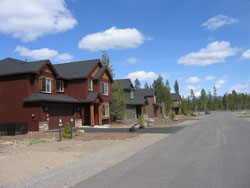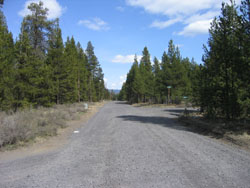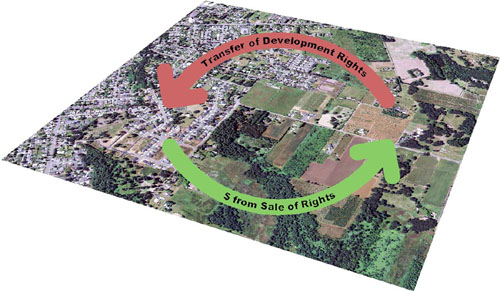

Photos: Views in La Pine, Oregon, of TDR receiving area (above left) and sending area.
A transfer of development rights (TDR) program supplements Oregon's regulations for protecting farm and forest lands by offering an incentive to develop elsewhere. A TDR program encourages development in urban and developed rural areas while preserving farms, forests, and natural resources. In a TDR program, property owners voluntarily convert their development rights to “credits,” which can be sold for use in other areas. Allowing property owners in one area to transfer building rights to a property in another area can be a useful tool for directing development away from resource lands or sensitive areas. This kind of voluntary, incentive-based program allows owners to gain the financial benefits of developing, without actually building anything.
The Land Conservation and Development Commission has adopted two programs for transferring development rights. The TDR Pilot Program described below allows for transfer from forestlands. The Measure 49 Transfer of Development Credits program allows the transfer of development rights established under Measure 49. Local governments must adopt a TDR ordinance before development rights can be transferred.
The
TDR Pilot Program was established to provide an alternative to residential development of land zoned for forest use. Residential development in forest zones may create conflicts with forest practices. Dwellings in forested areas can also increase the threat of fire hazard and the cost of fire suppression.
A local government wishing to start a pilot project must apply to DLCD along with partners, and propose both a sending area and a receiving area. Sending areas must be in a forest zone that has no more than four dwellings per square mile and is 10,000 acres or smaller. Receiving areas must be sized appropriately for the anticipated development right transfer and cannot be within 10 miles of the Portland metro urban growth boundary.
Applications are subject to approval from the Land Conservation and Development Commission. The local comprehensive plan and zoning ordinances must be amended to implement the TDR program within one year of approval.
To apply, interested governments should submit a complete
application form, a letter of interest, and a concept plan (described in OAR Chapter 660, Division 28). There's no deadline to apply.
Our staff can give technical help to communities wanting to start TDR programs. Please contact the DLCD Community Services Division Manager for more information or to arrange a meeting in your area with a DLCD representative.
 Local governments can focus on
Measure 49 properties for TDR programs when and where a Measure 49 claim exists. Receiving areas can be inside urban growth boundaries to direct future growth away from land outside the boundary. This has the added benefit of preserving undeveloped resource land for work as a farm, forest, or ranch. TDRs can be used to protect natural and cultural resources inside urban areas too. One of the most attractive features of TDRs is flexibility in meeting varied community goals.
Local governments can focus on
Measure 49 properties for TDR programs when and where a Measure 49 claim exists. Receiving areas can be inside urban growth boundaries to direct future growth away from land outside the boundary. This has the added benefit of preserving undeveloped resource land for work as a farm, forest, or ranch. TDRs can be used to protect natural and cultural resources inside urban areas too. One of the most attractive features of TDRs is flexibility in meeting varied community goals.
TDR programs are not without hurdles. Not every community has the right mix of conditions to sustain a program. Some factors that can affect success:
- The market must be under some pressure for more building in order to fuel demand for the purchase and sale of development rights.
- Receiving areas must have, or be able to accept, the infrastructure needed to handle increased population densities.
- Neighbors in receiving areas should be accepting of increased density. Concerns may be alleviated with design standards or with new public or private amenities that the neighbors support.
- Cities within the county may already have high residential densities.
- Local government must have the staff capacity to handle the administration of a TDR program.
Certain strategies can help. Designating new neighborhoods or transit hubs as receiving areas can help avoid neighbor opposition. Communities with high densities can use increased lot-coverage or floor-area ratios for commercial or industrial projects, or can grant waivers of requirements for parking or open space.
Overall, TDR programs require thoughtful, collaborative work to succeed. They involve an upfront commitment to local consensus on sending and receiving areas, as well as landowner and developer incentives. Successful programs also need a third-party entity to hold and monitor conservation easements for the long term. This will be a county or land trust in most cases.
A way of exchanging development credits also is needed. Local planning staff needs to keep records of development rights for each property. Some local planning departments even help facilitate rights transfers by setting up an online exchange or bank to assist buyers and sellers in finding each other.
Local governments must amend their comprehensive plans and zoning ordinances to create a TDR program. Typically special overlay zones are established for receiving areas to allow additional development.